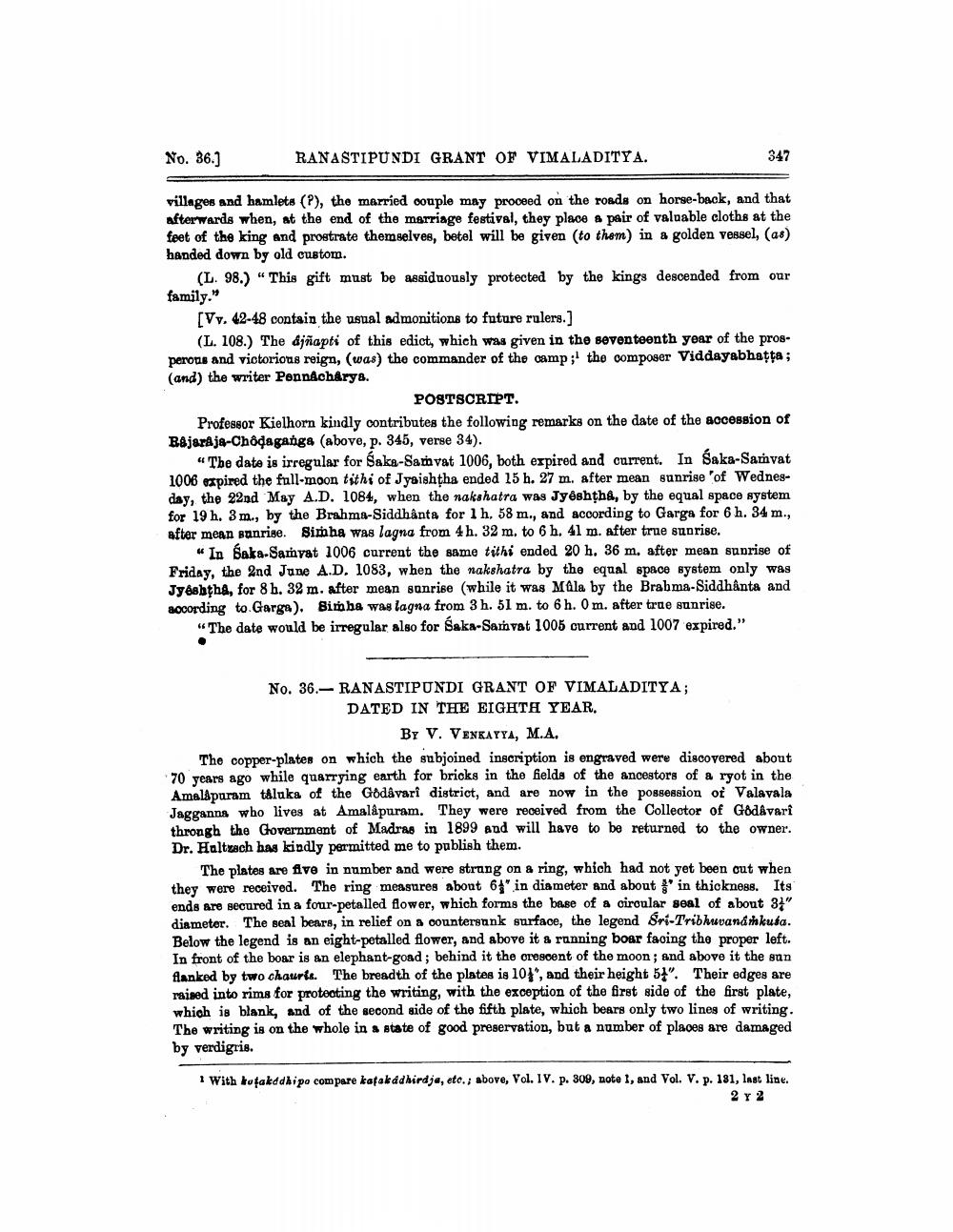________________
No. 36.)
RANASTIPUNDI GRANT OF VIMALADITYA.
347
villages and hamlets (P), the married couple may proceed on the roads on horse-back, and that afterwards when, at the end of the marriage festival, they place a pair of valuable cloths at the feet of the king and prostrate themselves, betel will be given to them) in a golden vessel, (as) handed down by old custom.
(L. 98.) “ This gift must be assiduously protected by the kings descended from our family."
[Vv. 42-48 contain the usual admonitions to future rulers.]
(L. 108.) The djñapti of this edict, which was given in the seventeenth year of the prosperous and victorious reign, (was) the commander of the camp;' the composer Viddayabhatta; (and) the writer Pennacharys.
POSTSCRIPT. Professor Kielhorn kindly contributes the following remarks on the date of the accession of Béjarája-Chôdaganga (above, p. 345, verse 34).
"The date is irregular for Saka-Samvat 1006, both expired and current. In Saka-Samvat 1006 expired the full-moon tithi of Jysishtha ended 15 h. 27 m. after mean sunrise 'of Wednesday, the 22nd May A.D. 1084, when the nakshatra was Jyêshtha, by the equal space system for 19 h, 3 m., by the Brahma-Siddhanta for 1 h. 58 m., and according to Garga for 6 h. 34 m., after mean sanrise. Simha was lagna from 4h. 32 m. to 6 h. 41 m. after true sunrise.
"In Saka-Samyat 1006 current the same tithi ended 20 h. 36 m. after mean sunrise of Friday, the 2nd June A.D. 1083, when the nakshatra by the equal space system only was Jy&shtha, for 8 h, 32 m. after mean sunrise (while it was Mala by the Brabma-Siddhanta and according to Garga). Biroba was lagna from 3 h. 51 m. to 6 h. O m. after trae sunrise.
"The date would be irregular also for Saka-Samvat 1005 current and 1007 expired."
No. 36.- RANASTIPUNDI GRANT OF VIMALADITYA:
DATED IN THE EIGHTH YEAR.
BY V. VENKATYA, M.A. The copper-plates on which the subjoined inscription is engraved were discovered about 70 years ago whilo quarrying earth for bricks in the fields of the ancestors of a ryot in the Amalapuram taluks of the Godavari district, and are now in the possession of Valavala Jagganna who lives at Amalapuram. They were received from the Collector of Godavari throngh the Government of Madras in 1899 and will have to be returned to the owner. Dr. Haltrach has kindly permitted me to publish them.
The plates are five in number and were strong on a ring, which had not yet been out when they were received. The ring measures about 6 in diameter and about f' in thickness. Its ends are secured in a four-petalled flower, which forms the base of a ciroular seal of about 31" diameter. The seal bears, in relief on a countersank surface, the legend Sri-Tribhuwana mkusa. Below the legend is an eight-petalled flower, and above it & running boar facing the proper left. In front of the boar is an elephant-goad; behind it the crescent of the moon; and above it the san flanked by two chauria. The breadth of the plates is 101, and their height 54". Their edges are raised into rims for protooting the writing, with the exception of the first side of the first plate, which is blank, and of the second side of the fifth plate, which bears only two lines of writing. The writing is on the whole in a state of good preservation, but a number of places are damaged by verdigris.
With hofakddhipo compare kafakadhirdje, etc.; above, Vol. IV. p. 309, note 1, and Vol. V. p. 191, lnst line.
2 Y 2




